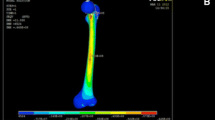Abstract
In this work a new distal interlocking system has been developed which is easy to use, allows a reduction of the operating time and consequently the exposure to radiations both for surgeon and patient. The main goal of this study has been the design of a new intramedullary nail for tibial fractures able to simplify and speed up the distal locking operation phases. After a preliminary stage during which several candidate concepts have been proposed and analysed, the best solution has been developed and deeply investigated. The new system, called “expansion nail”, has been firstly modelled by setting up a full parametric CAD model and, then, tested by running non linear FEM analyses to evaluate stresses and stability of the joining during normal working conditions. The new design has shown very high mechanical stability in the axial compression and torsional load cases. Since its very simple self-locking system, the new expansion intramedullary nail would reduce the operating time and the exposure to radiations for the surgeons as well as the patients.























Similar content being viewed by others
References
Brumback, R.J.: The rationales of interlocking nailing of the femur, tibia, and humerus: an overview. Clin. Orthop. 324, 292–320 (1996)
Leung, I.: Practice of Intramedullary Locked Nails. Scientific Basis and Standard Techniques. Springer, Berlin (2002)
Amin, A., Mahaluxmivala, J., Ramkumar, U., Hill, R.: Failure of the spiral blade and intramedullary nail in the treatment of ipsilateral femoral neck and shaft fractures. Injury Extra 38, 84–87 (2007)
Griza, S., Zimmer, C.G., Reguly, A., Strohaecker, T.R.: A case study of subsequential intramedullary nails failure. Eng. Failure Anal. 16, 728–732 (2009)
Bell, M.J., Beauchamp, C.G., Kellam, J.K., McMurtry, R.Y.: The results of plating humeral shaft fractures in patients with multiple injuries. J. Bone Joint Surg. 67B, 293–296 (1985)
Lin, J., Hou, S.M., Inoue, N., Chao, E.Y.S., Hang, Y.S.: Anatomic considerations of locked humeral nailing. Clin Orthop. Relat. Res. 368, 247–254 (1999)
Babin, S., Graf, P., North, J., Schvingt, E.: Le risqué septique de l’ostéosynthése à foyer fermé d’aprés une série continuede 1059 enclouages selon G. Kuntscher, Intern. Orthop. (1981)
Johnson, K.D., Tencer, A.F., Blumenthal, S., August, A., Johnston, U.: Biomechanical performance of locked intramedullary nail systems in comminuted femoral shaft fractures. Clin. Orthop. Relat. Res. 206, 84 (1986)
Wu, C.C., Tai, C.L.: A biomechanical comparison of unlocked or locked reamed intramedullary nails in the treatment of mid-third simple transverse femoral shaft fractures. Chang Gung Med. J. 29, 275–282 (2006)
Russell, T.A., Taylor, J.C.: Interlocking intramedullary nailing of the femur: current concepts. Semin. Orthop. 1, 217–231 (1986)
Rupp, R.E., Chrissos, M.G., Ebraheim, N.A.: The risk of neurovascular injury with distal locking screws of humeral intramedullary nails. Orthopedics 19, 593–595 (1996)
Arlettaz, Y., Akiki, A., Chevalley, F., Leyvraz, P.F.: Targeting device for intramedullary nails: a new high-stable mechanical guide; Injury. Int. J. Care Inj. 39, 170–175 (2008)
Abdlslama, Kalid M., Bonnaire, F.: Experimental model for a new distal locking aiming device for solid intramedullary tibia nails. Inj. Int. J. Care Inj. 34, 363–366 (2003)
Seidel, H.: Humeral locking nail: a preliminary report. Orthopedics 12, 219–226 (1989)
Knothe, U., Knothe, M.L., Klaue, K., Perren, S.M.: Development and testing of a new self-locking intramedullary nail system: testing of handling aspects and mechanical properties. Injury. Int. J. Care Inj. 31, 617–626 (2000)
Jovanovic, A., Pirpiris, M., Semirli, H., Doig, S.G.: Fixion™nails for humeral fractures. Injury 35(11), 1140–1142 (2004)
Giudice, F., La Rosa, G., Russo, T., Varsalona, R.: Evaluation and improvement of the efficiency of the Seidel humeral nail by numerical-experimental analysis of the bone-implant contact. Med. Eng. Phys. 28, 682–693 (2006)
Otto, K., Wood, K.: Product Design—Techniques in Reverse Engineering and New Product Development. Prentice-Hall, New Jersey (2001)
Parasaei, H.R., Sullivan, W.G.: Concurrent Engineering Contemporary Issues and Modern Design Tools. Chapman and Hall, Melbourne (1993)
http://www.bioimpianti.it/linea_trauma_omero-Clos.html (2009). Accessed 22 March 2009
http://www.synthes.com/ (2011). Accessed 17 Jan 2011
http://www.3dcontentcentral.com/ (2008). Accessed 18 Oct 2008
Goldstein, S.A., Choi, K.: A comparison of the fatigue behavior of human trabecular and cortical bone tissue. J. Biomech. 25, 1371–1381 (1992)
Seeley, R.R., Stephens, T.D., Tate, P.: Anatomy and Physiology, 3Rev Ed edn. Mosby College (1995)
Thibodeau, G.A.: Anatomy and Physiology, 6th edn. Mosby (2006)
Ionescu, I., Conway, T., Schonning, A, Almutairi, M., Nicholson, D.W.: Solid modeling and static finite element analysis of the human tibia. Mechanical, Materials and Aerospace Engineering Department, College of Engineering University of Central Florida, Orlando, Florida (2003)
Wang, G., Pan, T., Peng, X., Wang, J.: A new intramedullary nailing device for the treatment of femoral shaft fractures: a biomechanical study. Clin. Biomech. 23, 305–312 (2008)
Author information
Authors and Affiliations
Corresponding author
Rights and permissions
About this article
Cite this article
Ingrassia, T., Mancuso, A. Virtual prototyping of a new intramedullary nail for tibial fractures. Int J Interact Des Manuf 7, 159–169 (2013). https://doi.org/10.1007/s12008-012-0175-7
Received:
Accepted:
Published:
Issue Date:
DOI: https://doi.org/10.1007/s12008-012-0175-7




